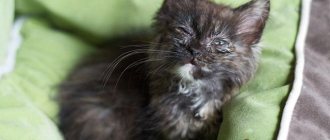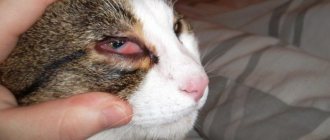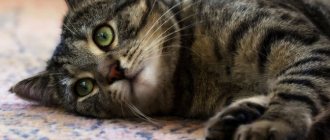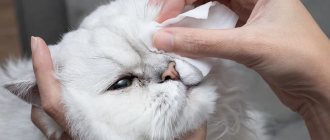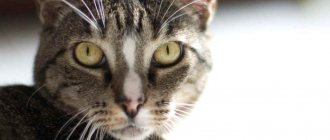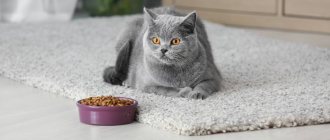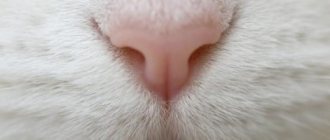Despite their cute appearance, cats are natural hunters. Nature has endowed them with sharp eyesight and the ability to see in the dark. Cats' eyes are designed so perfectly that they are almost immune to disease. According to statistics, cats suffer from eye diseases much less often than dogs. However, they also have problems. One of the main symptoms indicating a problem is redness of the eye and the area around it. What diseases are accompanied by redness? How to determine the cause and what to do when redness appears?
Possible reasons
Redness of a cat's eyes occurs for various reasons. Such problems arise due to physiological or pathological changes. An allergic reaction can trigger the appearance of redness.
You can find out what to do in this situation only after identifying the provoking factor.
Physiological reasons
The cause of hyperemia often lies in injury or exposure to irritants.
Such changes are observed in the following cases:
- Foreign body. Debris and dust entering the eye cause damage to the mucous membranes. In addition to redness, pain and tearing are noted.
- Irritation caused by soapy water, chemicals.
- Hanging fur. Such problems are observed in long-haired breeds. The hairs get on the cornea and injure it.
- Lens luxation. Develops due to injury, glaucoma, uveitis, cataracts. The iris takes on an abnormal appearance. The displacement is noticeable to the naked eye.
- Hyphema. The accumulation of blood in the anterior chamber is caused by injuries and poor blood clotting.
- Proptosis. Complete or partial loss of the eyeball is a consequence of damage to the organ of vision.
Pathological causes
The following eye diseases can cause redness:
- Blepharitis. Inflammation of the eyelid can be of an allergic or infectious nature. The eyelids become enlarged, discharge and itching are noted.
- Prolapse. With this pathology, the corners of the eyes turn red due to a change in the position of the lacrimal glands, their loss from the conjunctival sac.
- Conjunctivitis. There is thickening of the conjunctiva and profuse lacrimation.
- Tumor. Localized on the organ itself or tissues around the eyes.
- Ulceration of the cornea. Its surface layer is damaged. Associated symptoms are photophobia and pain.
- Dry keratoconjunctivitis. Develops in older cats. Little tear fluid is produced, and the cornea dries out. A burning sensation appears, bright light leads to irritation.
- Glaucoma. Increased intraocular pressure provokes destruction of the eye structure. The pupils dilate, the cornea becomes cloudy. In the absence of therapy, the optic nerve atrophies, resulting in complete loss of vision.
Infectious pathologies
Red eyes are often caused by infection:
- Mycoplasmosis . A severe pathology of an infectious nature, often leading to the development of pneumonia. In addition to the conjunctiva, joints, kidneys, and genitals are sometimes affected. Cough, nasal discharge, hyperthermia, inflammation of the conjunctiva should alert you.
- Chlamydia . The disease affects the organs of vision, respiratory tract, and gastrointestinal tract. In the conjunctive form of the disease, redness of the eyes is noted. There is a risk of vision loss.
- Calcivirosis . Affects the conjunctiva, mucous membranes of the mouth, nose, and joints. Pathology often leads to the death of the animal.
Glaucoma
The cat's eye is red and watery. Or both eyes rapidly turn red, the animal stops responding to light, and the eyes constantly “cry.” What should the owner do? First of all, take a close look at the symptoms. If the owner of a sick pet notices the following signs, then do not hesitate to visit a veterinarian:
- Loss of orientation in space.
- The pet's eyes are red.
- There is constant separation of tears from the eyes.
- The eyeball is swollen.
- The cat is unable to completely close its eyes due to the fact that the eyelids are swollen.
- The pupil is dilated.
- The pet does not react to light, or, on the contrary, photophobia occurs.
- The cornea becomes cloudy.
These are clear signs of glaucoma. The animal is in very severe pain. And only a veterinarian can alleviate it. If only because he will give you an anesthetic injection. And it is urgent to start looking for the cause of the disease. Once it is found, the disease is eliminated fairly quickly.
How to relieve your pet's suffering? Alas, it’s unlikely to be possible to do this on your own. This requires the help of a veterinary specialist. And the sooner the better.
Types of diseases
Regardless of the reasons, the following diseases develop with signs of redness of the eyes:
- blepharitis;
- conjunctivitis;
- third eyelid adenoma;
- prolapse of the nictitating membrane;
- eversion of the eyelids.
Blepharitis
The disease is often confused with conjunctivitis. However, there is a difference. Blepharitis begins with red, watery, and itchy eyes. The kitten scratches the organs of vision, inflammation of the eyelids leads to their closure. Treatment with drugs that work well for conjunctivitis does not bring relief.
Blepharospasm
Conjunctivitis
Inflammation is caused by micromycetes and bacteria that constantly live on the outer integument of the animal. The immune system prevents the rapid development of secondary microflora. But infectious diseases, external irritants, and intestinal worms weaken the defense, causing inflammation.
Chlamydia causes particular damage to the conjunctiva. These creatures, which occupy an intermediate position between bacteria and viruses, bother kittens from the age of four weeks. First one eye becomes inflamed, then the other. The disease is dangerous for humans; if handled carelessly, it can cause conjunctivitis.
Chlamydia conjunctivitis
Adenoma of the third century
This benign growth, resembling a soybean, is located near the bridge of the nose. Occurs as a consequence of injury or secondary infection. The bulge prevents the eye from closing, which leads to further injury and redness.
Adenoma of the nictitating membrane
The animal refuses food, becomes irritable and aggressive.
Prolapse of the nictitating membrane
Membrane prolapse is not an independent disease, but a symptom of the underlying one. If the disease affects one eye, then it is assumed that a speck or a congenital anomaly has gotten under the third eyelid. Bilateral inflammation is the result of infection of the organs of vision by secondary microflora during viral infections or helminthic infestations. Otherwise, the disease is called cherry eye. The angular seal of the organ of vision resembles a red berry in shape and color.
Eversion of the eyelids
Eyelashes come into contact with the eye sphere, injuring it. The disease causes pain, lacrimation, corneal hyperemia, and blepharospasm. Cats of exotic breeds are predisposed to the disease.
Cat bites are more likely to become infected than dog bites
Although cat bites are less common than dog bites, scratches are not uncommon. And those wounds inflicted by cats are five times more likely to cause infection, inflammation and suppuration of wounds than dog bites. This happens for two reasons.
- First, cat teeth are thin and sharp, so they penetrate tissue, tendon sheaths and joints of the human body much deeper than dog teeth, which are usually blunter and wider. With their bites they introduce infection into the wound.
- Secondly, cats tend to breathe through their nose. This means that their mouths are closed most of the time, which allows more bacteria to accumulate in the mouth and is more dangerous to humans.
Red eyes in kittens
If a kitten's eye is swollen and red, one can suspect the development of various pathologies that also occur in adult animals. Often similar changes are observed in pets during early weaning from their mother.
Symptoms occur in children with weakened immune systems. They need to be provided with a balanced diet and vaccinated in a timely manner.
Turkish Angora
Turkish Angora cats have a very interesting physique. They are distinguished by their special grace, soft long fur, and their heads are wedge-shaped like those of sphinxes. The size of such pets is quite large, and the color is most often white. Although red angoras are not an exception at all.
So, we have described the most popular cat breeds for which the red color is natural, although not obligatory. It is worth noting that with the same shade you can find other breeds of these cute animals, for example, Selkirk, Oriental, Canadian Sphynx, La Perm, Devon Rex and others. According to some legends, red cats are able to protect their owners from the negative influence of evil people, and bring prosperity to the house.
Diagnostics
Your veterinarian may order some tests, which include testing for the condition that causes red eye. The doctor will take your medical history and perform a physical examination to determine the underlying problem.
A complete ophthalmic examination is necessary to find the source of the eye redness. Your veterinarian may refer your pet to a veterinary ophthalmologist to evaluate your pet's condition using specialized equipment. During an eye exam, the following tests may be performed:
- Schirmer test for measuring tear quantity
- Fluorescein staining of the cornea to detect abscesses
- Tonometry to measure eye pressure
- Examination of the inside of the eye under magnification
- Scraping of inflamed tissue (eg, conjunctiva and cornea) for cytological examination for the presence of inflammation
- Eyelid scrapings to detect parasites
- Taking tissue samples to check for infections
- Biopsy of inflammation around the eyes
Siberian
Siberian cats are descendants of their relatives who lived in the wild steppes. Animals of this breed are distinguished by their very large size and heavy weight, which can reach almost 15 kilograms. Thanks to their ancestors, these pets have a special interest in hunting, and they always drag their prey into the house to show off to the owner.
Although Siberians are distinguished by their warlike, wild disposition, this does not prevent them from being very affectionate and devoted to their owners. Since these cats are very large and always go out hunting, it is not recommended to keep them in city apartments. For such “hunters”, private houses or dachas outside the city limits are more suitable.
Therapy tactics
Treating an animal at home without conducting a comprehensive diagnosis is strictly prohibited. It is necessary to promptly seek help from a veterinarian .
When the inflammatory process develops, antibiotics and eye ointments and drops are prescribed. If symptoms arise due to the development of another pathology, the underlying disease is treated. Only after this the remaining clinical manifestations are eliminated.
Some diseases respond well to treatment, while others require the use of medications throughout the pet’s life. Sometimes cure is impossible without surgery.
The following medications will help alleviate your pet’s condition:
- Furacilin. Used for the development of conjunctivitis. The affected mucous membranes are washed.
- Levomycetin. Used for bacterial conjunctivitis. The drug is instilled into both eyes.
- Tetracycline ointment. The medication is applied to the visual organs several times during the day.
- A solution based on novocaine, hydrocortisone (injection) helps eliminate pain.
Traditional medicine
Folk remedies will help cope with the problem only in combination with medications. Chamomile decoction is often used. It is prepared in a water bath and filtered. Wash your eyes three times a day.
Also used:
- Manganese solution. Light pink liquid. It is important that all grains are completely dissolved in water, otherwise there is a risk of damage to the mucous membranes.
- A decoction of St. John's wort, calendula, sage. It is used for purulent inflammatory processes. Used as a compress. The procedure is carried out 2-3 times a day.
- Black tea. For washing mucous membranes.
Maine Coon
Maine Coons were bred quite recently, but their temperament is quite wild. Although they are generally friendly, like most cats, they do show aggression quite often. They are quite large in size, and their weight can reach 16 kilograms. The color of the coat can be varied, including a red tint. Due to its size and weight, the Maine Coon cat is considered unique, and its appearance is simply terrifying to some, which continues to make it popular among connoisseurs of unusual pets.
First aid and prevention
Why do my cats always have red eyes? The reason is different in each specific case. The syndrome may be a consequence of violation of the rules for caring for the animal, or it may be a symptom of a serious illness. Therefore, if the redness does not go away for a long time, you should not delay a visit to the veterinarian. Only he can make a high-quality diagnosis, assess the pet’s condition and determine further treatment tactics.
If the owner does not have the opportunity to immediately go to the clinic, you can use first aid techniques for ophthalmological problems. They will help alleviate the pet’s condition somewhat and, in some cases, have a therapeutic effect.
- It is necessary to put a protective collar on the neck of a cat or kitten, which will prevent them from touching their eyes with their paws, and therefore prevent the risk of secondary infection.
- You should regularly remove discharge from the eyes and rinse them with cotton pads soaked in warm boiled water or a strong solution of tea leaves.
- To reduce the inflammatory reaction, you can instill antiseptic eye drops or an “artificial tear” drug.
- Hair hanging over the eyes should be trimmed more often so that it does not injure the cornea.
If you ignore a symptom such as redness of the eye sclera, you may miss the onset of a serious illness in your cat. It’s better to play it safe and take your pet to the veterinarian as soon as possible for an examination and consultation, so that you don’t have to regret the lost time later.
Are cat bites dangerous for humans?
Cat bites and scratches should not be ignored. They can lead to serious infections such as Pasteurella multocida, which occur when bacterial organisms of the Pasteurella species enter the body through punctures in the skin. This can lead to inflammation and suppuration of the subcutaneous tissue. Cats also often harbor the potentially dangerous organisms fusobacterium and streptococcus species, which can cause a wide range of infections such as tonsillitis and scarlet fever, as well as the bacteria bartonella henselae, which can cause a condition called cat scratch fever.
Preventive actions
Among the basic rules of prevention are the following:
- Carefully ensure that the cat does not injure its eyes when playing with other animals.
- When swimming, do not allow detergents to get into your eyes. This often leads to irritation.
- Hygienic procedures are carried out using products that do not provoke the development of an allergic reaction.
- Regularly wipe the corners of the animal's eyes with cotton swabs.
- Avoid getting hair in the eyes of long-haired animals.
Swelling and redness are the first symptoms of the onset of the inflammatory process.
If you notice that the cat begins to actively scratch the eye area, you should instill drops of artificial tears twice a day. With their help, it will be possible to eliminate irritation and dry mucous membranes.
It would be a good idea to consult a veterinarian. Pathologies at the initial stage are easier to treat.
Special protective collars will help prevent scratching of the affected area.
The best way to prevent ophthalmological pathologies is a caring and attentive attitude to the health of your pet.
The appearance of any negative changes or symptoms of inflammation is a reason to immediately contact a veterinarian.
This is the only way to preserve vision and avoid serious health problems for the animal.
Cornish Rex
The Cornish Rex is particularly graceful. Such cats are very active, playful, and their skin is covered with the most delicate, pleasant to the touch fur, which has the shape of rolling waves. A feature of animals of this breed should also be called “curls”. The color can be any, including a reddish tint. It is also worth noting that Cornish Rexes are descendants of one of the cats, which was born in the 50th year of the last century in the county of Cornwall in England.
Why are my eyes red?
If the owner notices that his pet’s eyes have become red, the possibility of developing some disease cannot be ruled out. Why does the cat have red eyes? This is what we will find out now.
Redness can occur for the following reasons:
- structural changes in the eye and accompanying diseases;
- viral or bacterial diseases;
- allergic reactions;
- eye injuries.
Only a veterinarian can make an accurate diagnosis. There is no point in postponing a visit to him. We will tell you about the most common and dangerous diseases, signs of which are red eyes in cats.
Allergic reaction
The owner discovered red spots near the cat's eyes. With what it can be connected? One option is allergies. Analyze what could have caused it. Have you changed the food? Did the cat eat something from the table? Have you tried a new cat weed? If the animal owner answered yes to one of these questions, then the following steps will have to be taken:
- Return to the cat’s usual diet.
- Closely monitor the animal so that it does not climb on the tables.
- Remove everything edible from the table.
- Return to the previous variety of cat grass.
As a rule, allergies go away on their own after the pet returns to its comfort zone.
If none of the above happened, and the red spots formed on their own, then it is advisable to go to a veterinary hospital in order to accurately diagnose and remove the cause of the formation of redness in the eyes.
Preparing for going to the clinic and treatment
0 Source:
Before going to the doctor, you need to write down or note for yourself exactly when the lacrimation began, which eye began to water first, the nature of the discharge, the animal’s diet in the last few days, treatment, vaccination or surgery in the recent past, the presence of additional symptoms. This will allow the veterinarian to quickly make the correct diagnosis and prescribe effective therapy. Typically, veterinarians prescribe drugs such as furatsilin, chloramphenicol, sofradex and kanamycin, which must be used in accordance with the instructions. To speed up recovery and alleviate the animal’s condition, you can resort to auxiliary therapy, unless, of course, we are talking about a bruise or allergy, and not a serious disease of the visual organs. Eyes can be washed with furatsilin solution, infusion of calendula or chamomile, and even regular black tea. These products have an antibacterial and soothing effect. Gently wipe the eyelid area with a cotton pad soaked in the infusion, remove the crusts and drip the medicine. During manipulations, it is advisable to seek the help of someone close to you. If this is not possible, the animal must be tightly secured, for example, with a scarf. It is important to speak kindly and calmly to the cat during manipulations, so as not to scare the animal, and be sure to reward it with some kind of treat upon completion.
Lichen
They took the pet to the dacha. Upon returning, the owner saw a red spot above the cat's eye. Stain and stain, did not attach any importance to this. It will go away on its own. And the stain began to grow. More precisely, they will spread across the animal’s face. Moreover, the fur fell out in this place. The owner anointed it with brilliant green but it didn’t help.
And it won’t help, because it’s very similar to lichen. And only competent prescription of medications and diagnosis can help. Ringworm is detected using a Wood's lamp or by taking material from the affected area of skin for further examination.
If the diagnosis is confirmed, the cat will be prescribed antifungal ointments. Treatment can be done at home by lubricating the affected areas. Just remember that lichen is a contagious thing. The pet is protected from other pets. And it is advisable to keep it away from household members.
Ringworm is treated for about 3 weeks. It is processed using disposable medical gloves. Immediately after the procedure, the gloves are disposed of.
Prevention of eye diseases
Of course, no cat can be completely immune from diseases of the organs of vision, but it is within the power of a person to do everything to ensure that the risks of such diseases are as small as possible. To do this, it is necessary to provide proper care for your pet’s eyes.
To prevent bacteria from multiplying in the mucus that periodically accumulates in the corners of the cat’s eyes, this mucus must be removed. To do this, you can use special disinfectant eye lotions or herbal decoctions.
When bathing your pet, you need to make sure that the soap solution and water do not get into her eyes and do not irritate them. The same precautions should be taken when treating your furry beauty against fleas and other parasites with insecticidal drops and powders.
If the domestic predator is a long-haired breed, you need to pay attention to the length of the hair above the cat’s eyes. If the hair hangs over, then it can scratch its delicate conjunctiva unnoticed by a person, but extremely noticeably for a cat, injuring them and, as a result, causing redness.
When performing any procedures on a cat’s eyes, the owner needs to be very careful not to scratch or damage the delicate organ of vision. Do not use dry wipes or cotton wool, as their fibers may get into your eyes. It is best to moisten a napkin or cotton wool in a special eye solution intended for cleaning or in a weak chamomile decoction.
Top best breeds of red cats
The top most popular breeds of ginger cats are headed by Persians, followed by the British and Scots. Exotics and Bengals are gaining popularity. Purebred Maine Coons attract attention with charming tassels on their ears and long silky fur. In addition, the list of popular breeds includes: Abyssinian and Siberian cats, Kurilian Bobtail, Turkish Van, Cymric, Savannah, Toyger, Somalia.
Persian
When you mention the Persians, your imagination pictures a well-fed, fluffy ginger cat. The red color of representatives of this breed is not too bright, it is rather creamy. Persians are loving and sociable. They easily find a common language with all family members.
The fur is thick, long, soft, and easily tangled. A lush collar adorns the neck, shoulders and chest. Such a fur coat requires careful care, and first of all, daily combing.
British
The British cat is associated with the color blue, but saffron milk caps are also common among representatives of this breed. The sunny shade is very rich and bright, and in combination with plush fur it looks amazing. The breed standard allows for 250 color combinations, but more or less solid colors are preferred.
Sunny Britons have coarser guard hairs, so the animals look larger due to the protruding hairs. The undercoat and guard hairs should be of the same tone without inclusions. The chin, tip of the tail and belly may be lighter.
Scottish lop-eared
The distinctive feature of the Scottish Fold is its round, ball-like head, flattened muzzle and drooping ears. The wool is fluffy, “cloudy”, very soft and pleasant to the touch. There are 1-3 folds on the ears.
Red color is rare. It is considered real luck to have a charming red-haired Scot. There is a pattern on a red background, most often a tabby.
Abyssinian
An intelligent and energetic Abyssinian has a strong and muscular body, long limbs and tail, a long neck, a wedge-shaped head, and large ears. The coat is thin, shiny, and harsh to the touch.
Representatives of this breed are flexible, independent, curious, loyal, and sociable. The red color of the coat is dark, rich, closer to copper, the tips of the guard hairs are dark in color.
Kurilian Bobtail
The Kuril Bobtail is a rare breed native to the Kuril Islands.
There are two varieties - short-haired and long-haired. A distinctive feature of the breed is its short tail. The body is strong and muscular, slightly tilted forward, the paws are large, the head is wedge-shaped, and the eyes are large.
Cats skillfully have a free character. They are affectionate, loving, inquisitive, and quickly become attached to people.
Orange color mixed with white and tabby is quite common.
Exotic
Exot is a close relative of the Persian. The animal has the same flattened muzzle and snub nose, strong build and square body. The coat is short and plush. One of the colors is red.
By nature, exotics are calm and good-natured. They are smart, playful and cheerful.
Siberian
Siberians are brave, loyal cats, born hunters. The animals have luxurious, long hair and a thick double undercoat. The iris of a rich orange-amber color evokes the admiration of connoisseurs of this breed.
The chic fur coat has light stripes and white inserts on the paws and shirtfront.
Maine Coon
The Maine Coon is a bright, presentable cat that resembles a lynx. Despite its serious appearance, it is a peaceful, responsive animal that can get along with all family members.
The most common color is white and red. Depending on the combination of tones, the following types are distinguished:
- bicolor - 50/50 white and red;
- harlequin - several red spots on the body;
- van - red head and ears;
- white tuxedo - against the background of the red color there is a white spot on the chest and white socks on the paws.
Turkish van
The Turkish Van is a semi-longhaired cat without undercoat. Red or chestnut spots with ring inserts at the base of the ears, on the body and tail stand out against the main white background.
Wool does not allow water to pass through, allowing Vans to swim to their heart's content.
Somalia
The Somali cat is a beauty with copper fur. Abyssinian is its closest relative. The Somali has a thick, long coat. The fluffy tail looks especially impressive.
There are dark spots on the head and tail. The iris is bright green. Representatives of the breed are smart, tactful, calm, patient and very sociable.
Cymric
Cymrik is a very calm, highly intelligent, people-oriented cat. Representatives of the breed were nicknamed little bear cubs due to their long, thick fur, compact build, rounded muzzle and small tail. Colors: tortoiseshell, white marble on a red background.
American Curl
The American Curl is a young breed of cat with curled ears. Animals are very calm and reasonable, have a balanced character. The coat is thin and soft, long or short.
Symptoms
Most cats diagnosed with hyphema have some degree of vision problems and discomfort. In cats, due to hemorrhages, visual acuity decreases and vision deteriorates.
- frequent blinking, squinting of eyes;
- tearfulness;
- inadequate reaction to pupil light;
- changes in behavior (depression, apathy, drowsiness, inactivity);
- pupil dilation;
- redness of the mucous membrane;
- swelling of the eyelids;
- decreased vision (monocular blindness if one eye is affected).
Important! Some cats experience acute pain and severe discomfort when opening or closing their eyes.
American Curl
A distinctive feature of cats of this breed are their upturned ears. There is little else that distinguishes them from the average cat. Their build and height are average. Health is usually normal. Curls have a playful, friendly nature, despite the fact that they are descendants of the only cat that was born in America in 1981.
What to do at home
Keep your cat at home as quiet as possible to stop bleeding, allow the hyphema to settle in the eye, and reduce the risk of further bleeding. It may be necessary to limit your cat's physical activity for 7-10 days.
Since in some cases vision deteriorates, it is recommended not to allow the cat to go outside without supervision until complete recovery.
Do not give your cat over-the-counter human medications such as Visine or other ophthalmic medications designed to reduce eye redness or irritation, as these products are not effective for hyphema.
Contact your veterinarian as soon as possible, because some causes of hyphema are dangerous not only for the eyesight, but also for the life of the animal.
Similar articles
Recently, veterinarians have observed a sharp increase in pancreatic diseases...
Mycoplasmosis in cats is a severe infectious disease that requires the intervention of veterinarians. Even…
Leave a request for treatment for your pet right now!
Nutrition
It is not advisable to feed albino cats natural food. They have much more sensitive digestion, and therefore some foods may be poorly digested and cause a negative reaction. Finding the optimal diet for such animals is much more difficult. In addition, some foods can cause the animal's fur to change color - a snow-white cat can easily turn yellow.
Dry and canned food is good for albinos. It is advisable to buy food labeled “for sensitive digestion.” Preference should be given to premium and super-premium class. Economy class food not only will not bring any benefit, but can, on the contrary, lead to digestive disorders.


